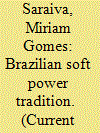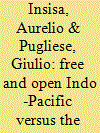|
|
|
Sort Order |
|
|
|
Items / Page
|
|
|
|
|
|
|
| Srl | Item |
| 1 |
ID:
127600


|
|
|
|
|
| Publication |
2014.
|
| Summary/Abstract |
Over the past decade, amid growing international fragmentation and declining US hegemony, Brazil has assertively expanded its participation in multilateral forums as part of a diplomatic strategy that envisions a reformulation of international institutions. At the same time, Brazil has also worked on building a leadership role within South America. These global and regional aims continue to shape the country's use of soft power. Indeed, soft power-defined by the political scientist Joseph S. Nye Jr. as influencing the behavior of others via attraction or persuasion rather than coercion or payment-is nothing new in Brazil's international dealings. Since the early 1900s, the nation has used such a strategy under different labels in conjunction with two beliefs central to its foreign policy: the need to build and assure Brazil's autonomy in its development strategy and foreign policy choices, and the desire to raise its global political profile
|
|
|
|
|
|
|
|
|
|
|
|
|
|
|
|
| 2 |
ID:
189250


|
|
|
|
|
| Summary/Abstract |
Recent scholarship suggests that the thawing of diplomatic relations between China and Japan has caused a readjustment of Beijing’s Belt and Road Initiative and Tokyo’s Free and Open Indo-Pacific Vision towards an emerging complementarity. Through careful process-tracking, elite interviews, and analysis of Chinese and Japanese primary sources, this article instead demonstrates how, outside of the East Asian spotlight, Sino-Japanese geo-economic competition continues in South Asia and the Mekong subregion, fueled by power politics and a mutual distrust of each other’s initiatives. On the basis of this evidence, this article qualifies Sino-Japanese interactions as a quest and denial for spheres of influence, whereas the Japanese government aims at denying Chinese spheres of influence. In doing so, this article highlights how Japanese proactivism from Sri Lanka to Thailand, via infrastructure and government financing, has become a driver of growing non-traditional security cooperation with India, the U.S., and Australia.
|
|
|
|
|
|
|
|
|
|
|
|
|
|
|
|
| 3 |
ID:
175552


|
|
|
|
|
| Summary/Abstract |
Spheres of influence remain one of the most pervasive phenomena in the practice and history of international relations, yet only rarely have they been taken up analytically. To bring conceptual and discursive clarity, this article advances two arguments. First, it argues that spheres of influence are not a distinct form of hierarchy in international relations, but rather practices of control and exclusion that can be found within any ideal-type hierarchy. Second, these hierarchical practices are generally underspecified by those invoking the term. Different theoretical perspectives on international relations offer highly divergent ways of understanding control and exclusion, and all do so with plausible empirical mooring. Spheres of influence do not themselves denote a form of governance even if it does a form of order construction and maintenance. Any given empire, hegemonic order, or alliance may also be a sphere of influence depending on the practices that occur; the key is not to identify whether particular hierarchical traits are dispositive of one of these relational structures, but rather whether, and the extent to which, assertions of control and exclusion define the hierarchy.
|
|
|
|
|
|
|
|
|
|
|
|
|
|
|
|
|
|
|
|
|